|
BUSH ON FIRE: PRESIDENT VISITS OREGONAUGUST 22 -- MEDFORD, OR: Responding to the rash of devastating wildfires that have swept the West this summer, President Bush is planning to ease restrictions on logging in national forests. Proposed changes to environmental laws would make it easier for fire management agencies to thin overgrown forests on federal lands; the President's plan would streamline the process for reviewing environmental effects of proposed logging projects and change the standards by which those proposals are approved. It also would allow government agencies to negotiate contracts, giving timber companies the right to sell the wood products they harvest in exchange for doing the work of thinning trees and removing dead wood.
But environmental groups claim the administration will gut safeguards that have protected the national forests for decades. "Our fear is that this is a backdoor way to open more land to commercial logging," said Allen Mattison with the Sierra Club.
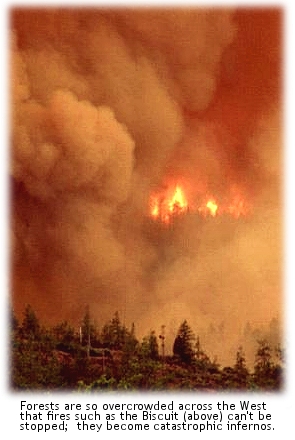 Administration officials said forest management changes are needed to reduce the fire risks. This summer, wildfires have burned more than 6 million acres from Alaska to New Mexico — about twice as much as in an average summer. Administration officials said forest management changes are needed to reduce the fire risks. This summer, wildfires have burned more than 6 million acres from Alaska to New Mexico — about twice as much as in an average summer.
Spokesmen for environmental groups today said the thinning of limited areas immediately near homes and other property might be acceptable, but that fires should otherwise be allowed to burn, to restore forests to their natural state.
Actions by environmental groups to protect forests played no part in the fire hazard, they said. "We're very concerned they will use the fires to further an agenda they've had for a long time — and that is to change key environmental laws," said Linda Lance, a Wilderness Society vice president.
But in southern Oregon today, Bush was well received as he proposed easing logging restrictions to prevent catastrophic wildfires, which are expected to cost $1.5 billion to fight this year.
Bush called for an end to the government’s "hands-off policy" in national forests, and said common sense is needed. Firefighter Cody Goodnough replied, "That will make our job easier."
"We need to understand," said Bush, "you let kindling build up and there’s a lightning strike, you’re going to get yourself a big fire."
Sen. Ron Wyden of Oregon, a longtime supporter of the environmental movement, lately finds himself under attack for his willingness to compromise — to allow increased logging in some areas in exchange for Republican support for a bill to ban harvest in old-growth forests in western Oregon. Wyden has been under pressure to do something, because Oregon has been particularly hard-hit by fires this summer, and he's agreed to expedited thinning in dry areas east of the Cascades in order to win Republican support for his plan to ban logging in other areas of the state.
Bush, though, today decried the "endless litigation" between environmental groups and the government. "We'll make sure that people have their voice," he said, "but aren't able to tie it all up."
Detailed reports are available from the Register-Guard, the Bellingham Herald, msnbc.com, CNN, abcnews.com, cbsnews.com, a local Oregon resident's perspective, and the Houston Chronicle.

WEATHER HELPS FIREFIGHTERS CORRAL SHEEP CREEK FIREAUGUST 22 -- WISDOM, MT: Rain showers, cool weather, and high humidity yesterday helped firefighters control a large chunk of the 1,900-acre Sheep Creek Fire; rehab work is already under way on parts of the burned area.
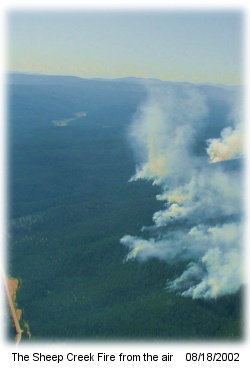 The Missoulian reported that more rain was predicted for today; fire managers decided to release three helicopters, and some of the crews on the fire will also be released. The Missoulian reported that more rain was predicted for today; fire managers decided to release three helicopters, and some of the crews on the fire will also be released.
Firefighters are still putting out hot spots and mopping up.
"This is some of the dirtiest work in firefighting, digging around finding those hidden hot spots," said Jack DeGolia, information officer with the Forest Service.
Crews yesterday were constructing and improving
fireline in preparation for a burnout; four residences were still threatened and structure protection is in place. The fire last night was 45 percent contained.
Strong winds pushed the Sheep Creek Fire northwest of Wisdom over the weekend, and the National Park Service was prepared to move artifacts from the Big Hole National Battlefield if evacuation became necessary.
The Beaverhead-Deerlodge National Forest temporarily closed the area between Bender Creek and the West Fork of Ruby Creek; press releases from the B-D are online.

MONTANA GOVERNOR WANTS AN END TO APPEALSAUGUST 22 -- MISSOULA, MT: Intending to ask for elimination of all citizen appeals of timber sales, Montana Gov. Judy Martz will meet with President Bush in Oregon today. "We've got to get rid of appeals — period," Martz said. "If we do something wrong, they can sue."
The Missoulian reported that by invitation of the White House, Martz will tour the site of Oregon's Squire Peak Fire. Bush will use the venue to announce relaxed restrictions on logging and limits on legal challenges to the cutting.
"Needless red tape and lawsuits delay effective implementation of forest health projects," according to a White House fact sheet released late Wednesday night. The new plan will streamline the Forest Service's environmental review process and change the standards by which timber sales are approved.
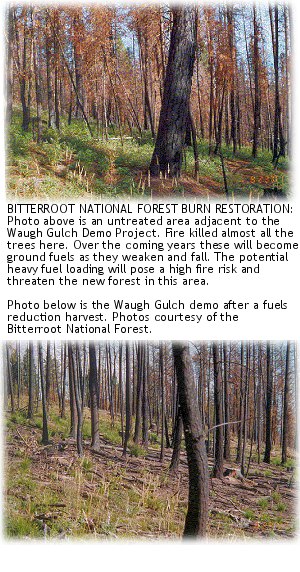 "While our forests burn, our professional land managers continue to be hamstrung by a broken process," said Martz, who was recently elected chair of the Western Governors Association. Martz said she'll use Montana — and the Forest Service's inability to quickly cut trees burned in the Bitterroot National Forest during the 2000 fire season — as "the best example of how badly the federal process is broken." "While our forests burn, our professional land managers continue to be hamstrung by a broken process," said Martz, who was recently elected chair of the Western Governors Association. Martz said she'll use Montana — and the Forest Service's inability to quickly cut trees burned in the Bitterroot National Forest during the 2000 fire season — as "the best example of how badly the federal process is broken."
Martz said while the Montana Department of Natural Resources logged its burned timber, the Bitterroot National Forest spent $1 million and 57 man-years of work writing an environmental impact statement on its salvage logging proposal. "And after all that work, the federal government still ended up in court," she said. "Fifty-seven man-years of work and $1 million later, and for what? It ended up being a mere 15,000 acres of salvage logging out of 307,000 acres burned."
But even before Bush unveils his proposal, the opposition is heating up.
In Medford, where Bush is expected today, the Mail-Tribune reported that environmental groups say the new plan will allow the logging of big trees while clear-cutting laws that protect the environment. "This is a problem we’re not going to log our way out of," warned Joseph Vaile with the Klamath-Siskiyou Wildlands Center. He says environmental activists support thinning of brush and small trees to protect rural communities but are opposed to logging the big trees.
"We’re afraid this will lessen citizen input and lead to logging that won’t reduce fire danger," he said. "What we’ll see is more brush encroachment and tree farms, creating areas that are more flammable than old-growth forests."
Timber industry representatives accuse the environmental community of using administrative appeals and the courts to halt timber-thinning sales, increasing the potential for explosive wildfires. The environmental groups counter they have opposed only timber sales that would log large trees. But Dave Hill, executive vice president of the Southern Oregon Timber Industries Association, disagrees. "That’s just a bunch of baloney," he said. "Almost all the thinning activities the agencies have been trying to do for the past 10 years have been protested or appealed. To say the White House is talking about cutting fire-resistant trees is nonsense."
The President's Healthy Forests Initiative is online.

BUSH TAKES AIM AT FIRE CRISISAUGUST 22 -- CRAWFORD, TEXAS: President Bush will propose today a new strategy to reduce risk of catastrophic fire, by encouraging thinning, easing regulation of forest management, and relying on private companies for more work. The Washington Post reported that Bush intends to alleviate a "fire crisis" produced by the increasing density of forests combined with counterproductive appeals, court injunctions, and environmental requirements that delay fuels reduction on federal land.
The plan would not limit thinning solely to areas closest to communities — as most environmental groups want. Resources for wildfire prevention and suppression should be focused where they can make a difference, according to William H. Meadows, president of the Wilderness Society. "The Forest Service is still spending too much time and money on backwoods projects that have nothing to do with protecting communities, and too little doing what is necessary to protect lives and homes."
But government agencies counter that the time and money spent on forest health projects — whether in the wilderness or the wildland/urban interface — is far too often too much time and money because of environmental appeals and litigation. Interior Secretary Gale Norton explained in USA Today that she and Agriculture Secretary Ann Veneman agreed with Western governors on a 10-year plan to manage high-risk lands. That plan sets forth regulatory changes to produce faster decisions on forest-thinning projects. "For example," said Norton, "a 430-acre thinning project near Medford, Oregon, involved six years, 830 pages of documentation, two environmental assessments, and several lawsuits before work was allowed to continue."
 Though the discussion's likely to get hotter before agreement is reached, it may be that wildfire itself could be the means for negotiating a truce in the West's timber wars. For more than a decade, loggers in hard hats have clashed against activists willing to chain themselves to trees. According to the Christian Science Monitor, the current crisis is opening up the possibility for innovative ways of making forest thinning commercially viable.
Though the discussion's likely to get hotter before agreement is reached, it may be that wildfire itself could be the means for negotiating a truce in the West's timber wars. For more than a decade, loggers in hard hats have clashed against activists willing to chain themselves to trees. According to the Christian Science Monitor, the current crisis is opening up the possibility for innovative ways of making forest thinning commercially viable.
The issue finally has the attention of Congress. "My state is burning up right now," said Sen. Ron Wyden of Oregon. "It's absolutely critical that we, on a bipartisan basis, move aggressively with a fuels reduction program to reduce fires."
Bush's proposal, according to the Chicago Tribune, prompted howls from environmentalists, but the administration said changes are necessary. "For the good of our economy, we need commonsense forest policy," Bush said during a stop at Mount Rushmore last week. "We can and we must manage our forests. We must keep them disease-free. We must have reasonable forest policies so as to prevent fires, not encourage them."
But environmental groups claim rules and regulations aren't the problem, according to the Denver Post. Environmentalists said handing over public lands to timber companies will only make things worse and could lead to logging of 100-year-old trees. "You can't help but think he's rather cynically using this opportunity to carry out an agenda for the timber industry," said Linda Lance with the Wilderness Society. "It has to do with logging, not forest protection."

FIRE-TRAP FORESTS: THE MESS IN THE WESTAUGUST 21 -- WENATCHEE WA: Before the 20th century, most fire across North America was "friendly flame," a natural part of forest ecosystems that removed unhealthy trees, thinned forest stands, freshened and replenished the soil, and encouraged biodiversity. But a report by msnbc.com explains that decades of well-intentioned efforts to put out wildfires, selective logging that harvested the most fire-proof trees, and a century of rapid development throughout the American West have left millions of public acres and thousands of communities at risk.
The forests and grasslands may look robust, but the last century's activity has created a national tinderbox. Many forests are so thick with flammable underbrush that when blazes do occur and firefighters can’t stop them, they become so massive that they ravage the landscape.
Jim Agee, a University of Washington fire ecologist, looks over the ponderosas and Doug-firs on the Wenatchee National Forest, over a green hillside dense with wild grass and shrubs. To his eye, it's an inferno in the making.
"This is the mess that we’ve got over millions of acres in the West," he says.
Environmental advocates say the government will use thinning as an excuse for commercial logging. But the Forest Service has a dual mandate to both preserve forests and manage them for economic gain, and a culture of mutual distrust has grown up around those sometimes clashing goals. "The Forest Service has focused its money and organizational energy on promoting commercial logging," says Sean Cosgrove with the Sierra Club. "They should define focus as a priority on protecting lives and communities."
Many agree that forest thinning and fuels reduction is badly needed. But should the Forest Service and other fire agencies try to be the "fire department" for residents who live in the wildland/urban interface?
Jerry Williams, director of Fire & Aviation Management for the Forest Service, says the Hayman Fire in Colorado is a good example. Firefighters saved more than 1,000 homes, but because they focused on protecting private property, the wildfire burned a vast landscape of trees, incinerated topsoil that no longer absorbs water, and filled parts of the Denver watershed with ash and mud. "Whenever we have to defend houses," he says, "there’s a hell of a lot of damage occurring in the back forty."
The Forest Service and four Interior Department agencies — the National Park Service, the Bureau of Land Management, the Bureau of Indian Affairs, and the Fish and Wildlife Service — each have different mandates for fire suppression on land they manage. The NPS seeks to preserve pristine habitats, for example, while the BIA manages land for many tribes that want timber cut for profit. Dozens of local, state, and tribal agencies also have fire responsibilities. With so many voices in the mix, little consensus exists about goals and methods.
"I don’t know of anyone that doesn’t think there needs to be more aggressive treatment of wildland areas," says Jay Thietten, a BLM fire management specialist. "What becomes a political hot potato is how we go about doing that, particularly on anything that’s economics-based."

RETARDANT DROP MAY HAVE KILLED 21,000 FISHAUGUST 21 -- BEND, OR: Preliminary reports show that 21,000 Fall River fish are dead after hundreds of gallons of fire retardant were accidentally dumped into the river. Small fish already are moving back into the affected area, but the Register-Guard reported that it could be years before the river recovers enough to regain its reputation as a premier flyfishing stream. A final report and an estimate of the economic impact should be ready in a few days, said Clair Kunkel, the Oregon Department of Fish and Wildlife's program supervisor in Central Oregon.
Six miles of the river were affected upstream from the confluence with the Deschutes, according to the Bend Bulletin. "Everyone wants to know the answer to the million-dollar question: How many fish?" Kunkel said. "Our very preliminary estimate is 21,000 in Fall River alone, but we're not going to be able to say about the Deschutes." At least 1,000 pounds and as much as 2,000 pounds of retardant accidentally was dropped into the river. Some structures were threatened, but the 9-acre fire was quickly controlled. The hatchery was not affected. Virtually all fish in the six-mile affected section were killed.
John Jackson, a unit forester with the Oregon Department of Forestry, said people have an emotional attachment to Fall River and its crystal-clear water, but they should remember that putting fires out before they destroy property is important. "We regret the fish loss and we don't take this lightly, but you have to put it into context," he said. "It's not a permanent loss. Folks need to understand that this is fire season and there have been a lot of casualties such as homes and natural resources. Unfortunately, in this case the casualties were the fish."

APPLE FIRE GROWS TO 6,800 ACRESAUGUST 21 -- GLIDE, OR: The Apple Fire on Oregon's Umpqua National Forest, about 20 miles east of Glide, is burning southeast in heavy timber toward the Twin Lakes area. About 23 homes are threatened; higher humidity and lower temperatures have helped suppression efforts, and structure protection is in place along Illahee Flat and the neighborhood of Dry Creek.
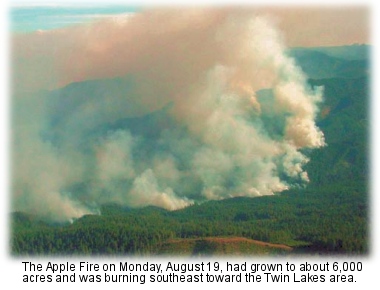 Flamelengths of up to 200 feet were a problem near Fairy Creek on Monday night as the fire made a run south toward the Tiller Ranger District. The good news, though, according to the Roseburg News-Review, is that the fire's moving farther away from populated areas on the north bank of the North Umpqua River. Flamelengths of up to 200 feet were a problem near Fairy Creek on Monday night as the fire made a run south toward the Tiller Ranger District. The good news, though, according to the Roseburg News-Review, is that the fire's moving farther away from populated areas on the north bank of the North Umpqua River.
"We had some pretty amazing runs last night in the Fairy Creek drainage on the west side of the fire," said Joe Molhoek, ops section chief on Tuesday. "But we've turned the corner at Horseshoe Bend and Apple Creek. The fire is heading south away from populated areas."
The fire is about four miles north of the Boulder Fire, which has burned into the North Umpqua Ranger District from the south.
Carlson's Type 2 team is managing the fire, and the ICP and fire base have been established east of Glide. Firefighters will continue today building indirect line along Panther Ridge and Twin Lakes Ridge; they hope to initiate a burnout when conditions are right.
The priority for now is to hold the fire to the south side of the North Umpqua River until more firefighting resources are available. "We didn't have any crews to get work done in the first day of the fire," said Bob Ramirez with the team. "Now we have crews arriving from all over the United States. We are getting air support from the Tiller Complex and weather has been cooperating."
About 570 firefighters are on the fire now, including 45 engines, 20 hand crews, and 11 dozers. Containment is estimated at 10 percent today, and full containment is predicted for the first of September.
A public information meeting is scheduled tonight at 7:30 p.m. at the Toketee Ranger Station. Incident information is available at (541)496-0235 and updates are online from the Apple Fire website.

GIT YER BISCUIT SHIRTS HEREAUGUST 21 -- BOISE, IDAHO: If you were one of the thousands of firefighters who rotated through the Biscuit Fire before the BISCUIT shirt was available, don't despair. Now you can get one from the Wildland Firefighter Foundation and shuck some of your hard-earned pay into a fund for the families of firefighters injured or killed on the job.
 If you were on the Biscuit Fire (or the Sourdough Fire or the Carter Fire or the Florence or the Biscuit Complex or the Sour Biscuit or the Florence or the North Florence or the South Florence or the Zone 1 Florence or the Zone 2 Florence or the Zone 3 Florence or the Zone 4 Biscuit) you heard about the little controversy over the naming of the fire. The good people of Florence, Oregon (a town) didn't like it that this fire was named after Florence Creek (a creek) and they were mighty glad when it was re-named again after the Florence Fire and the Biscuit Fire burned together. At least we think that's how it went. If you were on the Biscuit Fire (or the Sourdough Fire or the Carter Fire or the Florence or the Biscuit Complex or the Sour Biscuit or the Florence or the North Florence or the South Florence or the Zone 1 Florence or the Zone 2 Florence or the Zone 3 Florence or the Zone 4 Biscuit) you heard about the little controversy over the naming of the fire. The good people of Florence, Oregon (a town) didn't like it that this fire was named after Florence Creek (a creek) and they were mighty glad when it was re-named again after the Florence Fire and the Biscuit Fire burned together. At least we think that's how it went.
The Wildland Firefighter Foundation, a non-profit organization, established and maintains the Wildland Firefighters National Monument at the National Interagency Fire Center (NIFC) in Boise, Idaho.
The Foundation also provides emergency financial assistance to the families of fallen firefighters. Families left behind often find themselves with few resources, and the Foundation steps in to help. A wildland firefighter killed on the job often leaves behind family members who are not only overcome with grief and loss, but also bewildered by the prospects of surviving financially in a confusing world of financial disarray. No dollar amount of assistance can make up for the loss of a family member, but benefits that honor the service provided by firefighters can help.
The Foundation also provides cash assistance to families who must travel from out of state when a firefighter is hospitalized with injuries.
Profits from the sale of this shirt support the families of wildland firefighters. Do your duty and buy one.

THREE FIREFIGHTERS INJURED ON SIUSLAW RIVER FIREAUGUST 21 -- EUGENE, OR: Three firefighters were injured on a fire west of Veneta yesterday; one crew member fell off a vertical drop and broke five ribs, according to a report by KOIN-TV. A second firefighter also fell — while looking for the first man. He suffered a hairline fracture in his wrist. A third firefighter suffered torn ligaments when he slipped on a rock, but reports did not indicate whether he was looking for the first two when he fell.
All three were reportedly in good condition in a Eugene hospital.
According to KVAL-TV in Eugene, the injuries are an indication of the harsh conditions that firefighters are dealing with on this fire. The terrain is rugged and steep, littered with falling snags and even exploding rocks. About 100 members of the National Guard joined other crews on the fireline Tuesday. Firefighters are trying to get ahead of the fire while cooler, moister weather prevails.
The 775-acre Siuslaw River Fire is about 45 percent contained, burning in Douglas-fir, brush, and untreated slash. Minimal fire behavior was observed yesterday, with some creeping and smoldering. Crews are constructing and improving fireline and mopping up.

BUSH HAS NEW PLAN FOR LOGGINGAUGUST 21 -- CRAWFORD, TEXAS: President Bush is expected to announce changes that would speed up selective logging in national forests, to reduce fuels and help prevent the kind of fires that have plagued Western states this summer. But environmental groups are complaining that the government is upending decades of regulations, according to an AP report in the Statesman-Journal; they say the White House is using fear of fires to cut down trees that are old but healthy. Bush is expected to propose removing barriers to cutting timber from fire-prone forests by streamlining the environmental reviews that are required. The plan would make it harder for environmental groups to appeal logging and other management plans.
"We're all stuck on fires right now," said Susan Ash, wilderness campaign director of the Oregon Natural Resources Council. "But the Bush administration is talking about changes in environmental law on the books since 1970."
But, said Chris West with the American Forest Resource Council, "We've burned up half a million acres of Oregon's forests. It's high time the federal government began to seriously address concerns about the health of Western forests."
The Ashland Daily Tidings reported that Bush is expected tomorrow morning in Medford and will tour the site of the Squire Fire near Ruch. "He's going to lay out a policy on forest management," said Perry Atkinson, chairman of Oregon's Republican Party, "and I think if he does that, it could be very significant. One of the thoughts is will they let us do some salvage logging on the burned areas? There's a movement here to do salvage logging to support schools that's been proposed by (Jackson County) Commissioner Ric Holt, and that makes a lot of sense."
 www.russmo.com

OAK FLAT: EVACUATE, RETURN, NO, EVACUATE AGAIN, OKAY, C'MON BACKAUGUST 20 -- AGNESS, OR: The evacuation order that was in effect since last week for about 30 homes in the Oak Flat area near Agness was lifted by the Curry County Sheriff on Monday. The Curry Coastal Pilot reported that the decision was based on fire activity in the previous 24 hours and predictions for both weather and fire conditions. The evacuation order was downgraded to a "pre-evacuation alert."
But on Monday afternoon, just as deputies were notifying residents, a spot fire took off across the Illinois River — forcing the evacuation of about a dozen families.
"We're a little shaken," said Oak Flat resident Willis Crosse, a fishing guide and volunteer firefighter. "When (the fire) got to the other side, it was just like a blowtorch sitting at the bottom of the mountain. They had crews on it all night." Updates on the Biscuit Fire are available from www.biscuitfire.com
The spot fire was set off accidentally by firefighters on Monday, according to a later AP report. Fire spokesman Wayne Johnson said firefighters were clearing fuels around a house Monday afternoon, and the crew boss mistakenly believed he had permission to burn off the debris. The wind then whipped embers across the Illinois River; helicopters and firefighters standing by controlled the spot fire at about 50 acres.

SMALL PLANE CRASH NEAR LAKE TAHOE STARTS WILDFIREAUGUST 20 -- SOUTH LAKE TAHOE, CA: Two people died in the crash of a small plane Monday afternoon in a remote mountainous area south of Lake Tahoe. The crash ignited a 100-acre fire in the rugged Elbert Lake area about three miles south of Echo Summit. The Reno Gazette-Journal reported that strong winds grounded airtankers and pushed the fire; pilots working on the fire spotted the wreckage of the small plane in the middle of the fire area. The Showers Fire wasn’t threatening any structures or roads, but fire managers were concerned about winds and tinder-dry conditions. Cabins on South Upper Truckee Road were evacuated briefly, but the occupants were allowed to return by 7 p.m.
California Route 89 was closed from U.S. 50 in Meyers, California, to Picketts Junction in Hope Valley, mostly because of a lack of visibility caused by smoke. The fire is burning in Meiss Meadows, a popular hiking area with both the Tahoe Rim Trail and Pacific Crest Trail running through it. The blaze was named the Showers Fire because it was originally reported near Showers Lake, farther south in Meiss Meadows.

HIKER STILL MISSING IN OREGON FORESTAUGUST 20 -- REDDING, CA: A Shasta Lake couple is searching for a former Redding resident who disappeared while backpacking in fiery southern Oregon. Michael Woods, 32, left Miami Bar on the Illinois River on July 11, bound for the coast near Brookings. The Redding Record-Searchlight reported that Miami Bar to the coast would be a two- to three-week hike. Two days after Woods left, lightning torched off a fire that swept over his intended route. Woods still hasn't been found or heard from, and the Biscuit Fire has since grown into the largest in North America, at 448,857 acres.
"Nobody knows if he's alive out there," said his sister-in-law.
Woods, a U.S. Army veteran who served in the Gulf War, worked as a logger for eight years and was between jobs when he decided to take the backpacking trip. An outdoorsman who was experienced in nature and yearned to try a long-distance hike, Woods carried a backpack with fishing gear, some food, and a compass — but no map, according to family members. He's described as 6 feet tall, 170 pounds, with dark brown hair and blue-green eyes.
No formal search of the area has been conducted since the fire continues to burn, said Lt. Brian Anderson of the Josephine County Sheriff's Department. Heavy smoke has made it impossible to conduct an aerial search; fire crews and pilots on the fire have been told to watch for Woods, but have had no luck so far.

COLORADO SMOKED OUT WITH 25,000 ACRES ABLAZEAUGUST 20 -- STEAMBOAT SPRINGS, CO: Three wind-driven fires exploded to cover more than 25,000 acres in northwest Colorado on Sunday. "With the wind and the smoke, we have not been able to use aircraft much to either assess the acreage or stop the spread," said Mary Peterson, supervisor on the Medicine Bow - Routt National Forest. The Rocky Mountain News reported that all three fires were caused by lightning.
The Burn Ridge Canyon and Hinman fires are burning through 14-foot-high stacks of logs from a 1997 blowdown in the Mount Zirkel Wilderness Area — and hundreds of acres of beetle-killed timber. The two fires are only 5 percent contained. Thirty residences and five commercial properties and ranches are threatened.
"We always knew that the natural cycle of things — the blowdown, the beetle infestation and the epidemic moving outside the blowdown — would occur," Peterson said. "The weather is extreme, dry and hot, and the fire behavior is extreme." The Green Creek Fire, burning in the Service Creek Wilderness Area south of Steamboat, grew to about 3,800 acres and threatened 20 to 30 residences. By Sunday evening, the fire was 45 percent contained.
More than 250 firefighters are on the fires. Six helicopters and four airtankers were assigned to the Green Creek Fire.

PLACER COUNTY FIRE MAY BE ARSONAUGUST 20 -- AUBURN, CA: Crews are battling a fire this morning that burned dangerously close to several foothill homes; KCRA-TV reported that the Ponderosa Fire started about 11 p.m. Sunday and burned about 80 acres between Forest Hill and Weimar in Placer County.
"It started right along Ponderosa Road," said CDF Division Chief Loren Snell. "One of the challenges we have is that during the night and the early morning hours we have down-canyon breezes, so (Monday) when the southwest flow comes in, the up-canyon breezes will engage and the fire will become active and move up-canyon."
Eight crews and 15 engines are battling the fire on the ground, and fire managers said airtankers would arrive this morning. During the night, the fire burned close to several homes in the Eagle Crest subdivision, but crews were able to fight back the flames and no homes were damaged.
KCRA-TV has video online.

APPLE FIRE GETS UP AND GOESAUGUST 19 -- STEAMBOAT, OR: Heavy smoke and fire danger from the Apple Fire, 21 miles east of Glide, prompted the Oregon Department of Transportation to close Highway 138 East between Mileposts 38 and 50 — and no estimate for reopening the highway has been announced.
 The Roseburg News-Review reported that the fire was called in Friday morning; Scott Brayton, information officer with the Forest Service, said the Apple Creek Campground was closed. The Roseburg News-Review reported that the fire was called in Friday morning; Scott Brayton, information officer with the Forest Service, said the Apple Creek Campground was closed.
"It started at about 10 or 15 acres, and just blew up," Brayton said. "They had wind out there like you wouldn't believe. It got into those canyons and just went."
Flames spread in all directions from the ignition point, right up to the southern bank of the North Umpqua River next to the campground.
Saturday afternoon a pall of smoke hung over the highway, and a smoke column thousands of feet high was visible from miles away.
Firefighting resources in the area are strained. Initial incident commander Lyle Burmeister said he had no more than 100 firefighters and no aircraft permanently assigned to his fire as of Saturday night. That lack of resources led to a cautious approach in suppression plans. "The slopes are steep, the fire is hot, the winds are high," said Burmeister. "As a result, because of firefighter safety concerns, we've pulled back some."
Howard Carlson's Type 2 team has since taken over the fire, and they expect significant growth before the fire is contained. "I would project right now, based on current conditions, about 12,000 acres," said Carlson. One of the team's priorities will be to hold the fire to the south side of the North Umpqua River until more firefighting resources are available.
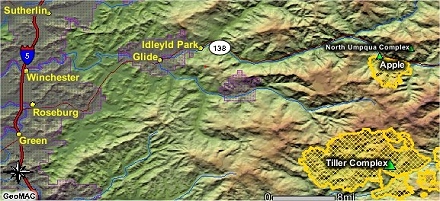
The fire last night was listed at 6,000 acres and zero percent containment. About 125 firefighters were on the fire, including five hand crews, 13 engines, six dozers, and three water-tenders. Extreme fire behavior with short crown runs and spotting up to a mile ahead of the fire was a problem yesterday; the fire's burning in heavy timber. Twenty homes and several outbuildings are threatened; structure protection is in place along Illahee Flat and the neighborhood of Dry Creek.
A public information meeting is scheduled for Tuesday, August 20 at 7:00 p.m. at the Glide Community Center, 20062 North Umpqua Highway. The meeting will include information on the Tiller Complex.
A road closure remains in effect from just east of the Steamboat Inn to milepost 55 at Soda Springs, a distance of approximately 14 miles. "Currently, there is no estimated time for re-opening the highway," according to DOT reports. For updates on the road closure, call (800)977-6368 or check with DOT online for current status on the Highway 138 closure.
Updates on the Apple Fire and the Tiller Complex are available online from the Umpqua National Forest.

ANOTHER 300 FIREFIGHTERS MAY BE HEADED FOR OREGON'S SIUSLAW RIVER FIREAUGUST 19 -- EUGENE, OR: Firefighters on the 440-acre Siuslaw River Fire got some good news yesterday when they learned that the East Antelope Fire near Ashland had been contained. About 700 firefighters are being demobilized from there and sent to other parts of the state, according to a story in the Eugene Register-Guard. "Now that they're finishing up that fire, we're going to get some more people up here," said Tom Berglund with the Oregon Department of Forestry.
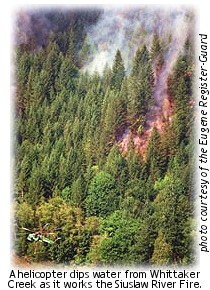 Crews de-mobed from the East Antelope will be reassigned to other fires in the region — such as the 6,000-acre Apple Fire on the Umpqua National Forest — but Berglund said he expects another 300 or so firefighters on the Siuslaw River Fire over the next few days. Crews de-mobed from the East Antelope will be reassigned to other fires in the region — such as the 6,000-acre Apple Fire on the Umpqua National Forest — but Berglund said he expects another 300 or so firefighters on the Siuslaw River Fire over the next few days.
About 200 firefighters were on the fire yesterday, including crews from ODF, the BLM, and Roseburg Resources, along with at least six helicopters that have been dipping from Whittaker Creek.
What was a raging fire on Saturday night has shifted directions and moderated with cooler, more humid weather. Mair's ODF team is assigned to the fire; it's 18 miles west of Veneta and is burning in Douglas-fir, brush, and untreated slash. Containment is estimated at only 10 percent, but higher relative humidity has moderated fire activity, with only occasional torching still occurring. Crews are building fireline and burning out.
Siuslaw River Road was closed at milepost 2 because of the fire.
The forested area west of Highway 126 where the fire started is no stranger to wildfires. In the fall of 1999, the Austa Fire reached more than 1,000 acres and threatened about a dozen rural homes near Walton.

JUST LET 'EM BURN?AUGUST 19 -- MINNEAPOLIS, MN: Another severe fire season in the national forests is burning far more than just forests and grasslands, and it's killing not just firefighters but also research, trail maintenance, partnerships with non-profit organizations and universities, and wildlife habitat restoration. An editorial published today by the Minneapolis Star-Tribune explains that policy directives from the White House have subsidized firefighting expense by eliminating work in other programs of the U.S. Forest Service.
"The Bush administration argues that firefighting efforts must be brought under clearer policy guidelines and stricter fiscal control," said the paper's editors. "But its opposition to emergency appropriations will not, on its own, do much to accomplish such goals. The Forest Service has always found ways to spend more on fire than it was supposed to, then get reimbursed; what it needs is political backing to let more fires burn."
Timber revenues are so low that the agency must now raid other programs to cover its firefighting outlays, which are projected to reach $1.3 billion to $1.5 billion for 2002.
"If the White House wishes to bring rationality and discipline to firefighting, it could begin by taking a hard look at the social value of spending such huge sums of money — and, on average, 17 firefighters' lives each year — chiefly to protect the vacation homes that are mushrooming in the wildland/urban interface," suggests the editorial. "It might be more cost-effective to let those woodland chateaus burn down and pay their owners full replacement cost."

LITTLE TREES SPUR BIG DEBATEAUGUST 19 -- ASHLAND, OR: Thinning small-diameter trees from forests is a crucial part of reducing wildfire risk, but financing removal of the trees remains a daunting challenge. Limited markets exist for the small trees now choking the nation's forests, according to a report by the Ashland Daily Tidings; the price tag for thinning in southwest Oregon alone is $2.7 billion, according to Jeremy Fried, leader of a U.S. Forest Service Pacific Northwest Research Station team that examined forests from Roseburg to Ashland. "It's just a killer economically," Fried said. That price tag would be even higher, but the team factored in revenues from the sale of medium trees, thus offsetting the costs of expensive thinning operations.
Dave Hill, executive vice president of the Southern Oregon Timber Industries Association, said the market for trees eight inches in diameter or less is subject to swings and has been in a slump for the past few years. "There's too much supply," Hill said. "There's a huge volume of that type of wood fiber that can't be used economically. It's a matter of an overwhelming volume of brush and 8-inch and smaller material." He added that trees 8 to 16 inches in diameter have economic value; a lathe can be used to peel thin sheets from trees for use in veneer and plywood. Hill said timber companies regularly cut small trees from their land to protect forests, and would like to see public land managers follow the same practice.

OREGON'S FIRE BUDGET HALF GONEAUGUST 19 -- COOS BAY, OR: Rising firefighting costs on state lands have burned up nearly half of Oregon's $43 million fire insurance policy and will bring the Oregon Department of Forestry before the legislative Emergency Board in September to ask for an increase in spending authority. The Coos Bay World reported that Sen. Ken Messerle, Republican chairman of the state Natural Resources Committee and a member of the Emergency Board, said that with two of the driest months remaining in the current fire season, the state needs to keep the pressure on aggressively battling fires to limit losses to Oregon's resources. "It's way too early to think we're even over the hump," Messerle said.
In a recent memo to the Emergency Board, ODF identified a need for an increase of nearly $40.25 million to the expenditure limit and a $4.27 million appropriation to the general fund to finish out the biennium.
"The limitation increase will accommodate coverage of costs of fire suppression to-date and the general fund appropriation will provide funding to help meet the insurance policy deductive and preparedness/suppression costs," State Forester Jim Brown wrote. This year's wildfires have diminished the agency's cash reserves, and ODF indicated it may seek a loan from the state Treasurer to match its short-term cash flow requirements.

BISCUIT FLANK PUTS UP A 20,000-FOOT PLUMEAUGUST 18 -- AGNESS, OR: Things were a little calmer yesterday afternoon along Oak Flat and Agness, and homeowners on evacuation notice were hoping for the best. Then the fire exploded.
Within an hour Saturday afternoon, according to ABC reports, the northwest flank of the fire blew up and raised a plume of smoke to 20,000 or 30,000 feet. People grew more nervous by the hour. "Normally, it's pretty stress-free living," said Gayle Soule, owner of the Old Agness Store. "When you go to sleep at night and you hear helicopters, and fire trucks ..."
By Sunday, 435,654 acres had burned and more than 6,500 people were fighting the blaze, including 470 Canadians, 39 Australians, and nine fire managers from New Zealand. The fire was 35 percent contained. Crews gained ground on the fire's northwestern flank Sunday; they finished a fireline around Agness and plan burnouts along the west flank near Pistol River and Gardner Ranch.
A well attended fire information meeting was held at the community center in Agness last night; favorable north winds and ideal burning conditions allowed effective burnouts in zones 1 and 4. Fire managers say that smoke from the fire may negatively affect the communities of Gasquet, Hiouchi, Crescent City, Arcata, and Eureka.
The evacuation notice for the entire Illinois Valley was lifted last Friday, but a pre-evacuation advisory remains in effect for the residents of Agness, Illahe, Cate Road, Gardner Ridge north of Wilson Prairie, the Upper Pistol River drainage near Gardner Ranch, and Wilderness Retreat. More information's available online at www.biscuitfire.com with maps and regular updates.

DEATH-BENEFITS LAW FAILS FIREFIGHTING PILOTSAUGUST 17 -- DENVER, CO: Six summer wildfire deaths in airtanker and helicopter crashes have renewed a debate about a federal law that pays death benefits to the families of many firefighters but excludes others. A report in today's Rocky Mountain News explains that flight crews on airtankers and helicopters get nothing from the Public Safety Officers' Benefits program, which helps the families of law officers, paramedics, and firefighters killed in the line of duty.
 The U.S. Department of Justice has interpreted the language of the 26-year-old law to cover only workers employed by or volunteering for a government agency. Firefighters employed by contract companies on a fire are not covered. About a third of groundpounders are contract employees, and all the flight crews on airtankers and helicopters are. None are eligible for the federal death benefits. The U.S. Department of Justice has interpreted the language of the 26-year-old law to cover only workers employed by or volunteering for a government agency. Firefighters employed by contract companies on a fire are not covered. About a third of groundpounders are contract employees, and all the flight crews on airtankers and helicopters are. None are eligible for the federal death benefits.
Rep. Barbara Cubin, a Wyoming Republican, is floating the idea of insuring contract pilots under the program. "These pilots are basically on the front lines of fighting these fires," her press secretary Joe Milczewski said. Another new bill in California would require any firefighting company signing a contract with the state of California to provide life insurance to its pilots equivalent to that available to a government employee.
California State Assemblyman Dick Dickerson, a Republican from Redding, also is pushing a resolution to add firefighting pilots to the PSOB program. He was struck by the deaths in August 2001 of tanker pilots Larry Groff and Lars Stratte, who were killed when their planes collided as they fought a brushfire.
"It's just amazing what they have to fly through to drop those loads," Dickerson said. "They need that protection that we should give them. In the long run, they save government a lot of money. If you didn't have contract pilots, you'd have to have state employee pilots on the payroll year round, costing much more money than giving death benefits to the pilots."
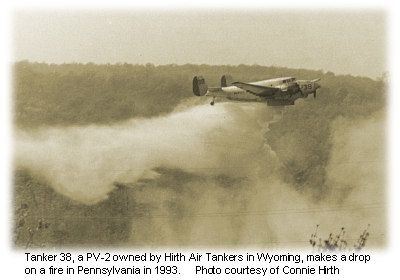 Connie Hirth of Hirth Air Tankers in Buffalo, Wyoming, is among those fighting to get the program extended to cover aerial firefighters. Connie Hirth of Hirth Air Tankers in Buffalo, Wyoming, is among those fighting to get the program extended to cover aerial firefighters.
"True, the pilots are flying for private contractors," she said, "but they are flying on state or federal land, and they are protecting lives, they're protecting wildlands, they're protecting property."
Vicki Minor, executive director of the Wildland Firefighter Foundation, is among those in the industry who are pushing for an extension of the program.
"It is such an unjust state in our fire community that all firefighters do not have access to those funds," Minor said.
The Wildland Firefighter Foundation provides cash payment support to surviving family members. The Foundation is one of the few available sources of funding for families with emergency needs for expenses. For more information, contact the Foundation staff:
Wildland Firefighter Foundation
1310 Vista Avenue #22
Boise, Idaho 83705
(208)336-2996

GYRO-TRAC CHEWS FIREBREAKS FOR LAKE COUNTY WATER AUTHORITY IN FLORIDAAUGUST 17 -- LEESBURG, FL: The Gyro-Trac smashes like a tank through the dense hammock and brambles of Fern Prairie Preserve, devouring everything in its path. The firebreak it cuts is covered in mulch — just what the Lake County Water Authority ordered. The state Division of Forestry owns the Gyro-Trac machine, and according to the Leesburg Daily Commercial, the DOF is working with the Water Authority to build firebreaks that will not only help protect nearby homes but also open up the land for future park management.
"This is primarily for wildfire protection and to clean up the area," said Patricia Burgos with the Water Authority. Their land is primarily forested uplands and wetlands; the hammock and pine forest is overgrown, and dozens of homes along the boundary have grown into a fire-prone interface. Some homes are just 10 feet away from the fenceline bordering the property - too close for DOF comfort.
"When housing comes closer than a quarter of a mile it becomes a concern," said DOF Forest Ranger and Gyro-Trac driver Steve Bennett. "Creating defensible space is our objective. It also gives us access to clean up the property and allow for prescribed burns." The Gyro-Trac, used throughout the state, provides an environmentally riendly way of "paving" firebreaks with mulch. "An ordinary bulldozer plow compacts the soil and leaves a sandy canal in its wake," said Pat Gurnee, senior forest ranger for the DOF. Gurnee says the Gyro-Trac mulches everything in its path, and can work on soil that would bog down a bulldozer. More information's online from gyrotrac.com and the Florida Division of Forestry.

FIRE SPENDING DRAINS AGENCY FUNDSAUGUST 17 -- PORTLAND, OR: The U.S. government expects to spend upward of $1.5 billion battling wildfires this year, making it by far the most expensive firefighting year in the nation's history. As fires across Oregon and the West consume record sums of money, they also illuminate a budget tug-of-war between Congress and the Bush administration. Members of Congress approved extra firefighting cash, but the president is asking for new controls on wildfire expenses.
A report in The Oregonian notes that this year's cost projection forced a budget freeze on non-fire programs and cutbacks throughout the U.S. Forest Service, which already has spent more than twice its $321 million firefighting budget. Field offices are suspending road and trail maintenance, land purchases, fish and wildlife habitat work, replanting of logged or burned areas, and more.
The Forest Service's Pacific Northwest Research Station in Portland expects to cut $11 million from its $53 million annual budget, forcing cancellation of contracts with Oregon State University and the University of Washington.
Though Congress traditionally has reimbursed land management agencies for firefighting costs, the Bush administration has taken a hard line this year against supplying extra money. The administration strongly opposed $700 million in emergency fire suppression money Congress had inserted into a Forest Service budget bill. On Tuesday, the president shot down a $5.1 billion package that included an extra $50 million for firefighting. Presidential refusal to pay for firefighting expenses has forced the Forest Service to transfer money from its day-to-day programs to cover fire costs.
Other federal agencies, such as the BLM and BIA, expect to spend $300 million or more on fire this year. That exceeds their wildfire budget, but they have borrowed from backup accounts without affecting ongoing programs.

FOREST SERVICE JUST SAYS NO TO FIRE-TROLAUGUST 17 -- BOISE, ID: The U.S. Forest Service is abandoning one of its top weapons against wildfires — a retardant mixture that under some circumstances can produce cyanide, according to a KRT Newsfeatures story. Forest Service officials say they're concerned about laboratory tests that show the slurry is a danger to wildlife, and they don't want to take a chance by continuing to use it. Some experts say the slurry — made by Fire-Trol — is safe and necessary for attacks on massive wildfires such as those that have plagued the drought-stricken West.
Laboratory tests show it can be toxic to aquatic life, but the Forest Service will continue using Fire-Trol products until its contract with the company expires in 2004, according to a report by the Daily Camera. Lab tests show that when Fire-Trol brands are exposed to sun and water, they briefly can release small amounts of cyanide that could harm fish. Fire-Trol contends there is no evidence of that outside the laboratory.
"We don't see any evidence that that's happening in the real world," company spokesman Robert Crouch said. But the Forest Service is playing it safe.
"We just determined that it would be prudent not to utilize a product containing that particular chemical," said Alice Forbes, branch chief for equipment and chemicals at the National Interagency Fire Center in Boise, Idaho.

CANADIANS UNIMPRESSED WITH U.S. FIRE FOODAUGUST 17 -- GOLD BEACH, OR: A firefighting crew from Canada, working in 90º heat on southern Oregon's Biscuit Fire, told the Curry Coastal Pilot they don't think much of the chow on the fire.
"The lunches are kinda bad," said Greg Henderson.
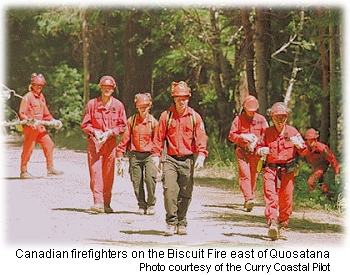 He holds up a sandwich, eight layers of meat spilling out the sides of the white bun. "I'd rather have two or three sandwiches. It's kinda gross like this." He holds up a sandwich, eight layers of meat spilling out the sides of the white bun. "I'd rather have two or three sandwiches. It's kinda gross like this."
Henderson reached into his pack and pulled the rest of his meal out. "Some cookies, Hot Tamales, and a cheesestick. It's not really all that healthy," he said.
Matt Nealis, leader of the crew consisting of 13 Hazelton "Rainmakers" and seven Houston "Thunderdogs," said the firefighters are expected to eat at least 6,000 calories a day. Normal average daily intake for a person not fighting fire is 2,500 calories.
"When I first got here, I worked the (chainsaw) for about 20 minutes and I was pooched," Henderson said. "You have to make sure to eat enough to make it through the 12-hour days."
The heat has been troublesome for firefighters across Oregon the last couple weeks, and some have been treated for dehydration. The Canadians, working a few miles east of Quosatana, though, have recently had a different minor problem with water. They've been cutting brush and trees near a road, and a tanker truck loaded with water runs up and down the road, spraying behind it.
Some of the firefighters grumble that the trucks keep spraying their backpacks.
Although the lunches may not be great, and the firefighters are tired of wet backpacks, they all agree that they want to continue fighting the Biscuit Fire. In fact, most say they'd like to get a bit closer to the fire.
"It's been sort of a slow season up in B.C., so it feels great to be here and helping out on such a big fire," said Dan Burns of the Hazelton crew.

FIND THE ARSON TRUCK, GET A REWARDAUGUST 15 -- PRESCOTT, AZ: Investigators are looking for a pickup truck in connection with the Indian Fire near Prescott in May. The fire burned 1,300 acres and destroyed six homes. According to 12news in Arizona, investigators determined that the fire was human-caused. They are looking for anyone who may have seen a red pickup truck near Indian Creek Road on May 15 around 2:30 p.m. The wildfire was first spotted around that time near Indian Creek Campground. A reward is being offered for information leading to an arrest and conviction regarding the fire. Email 12news if you have information.

RED, ORANGE, YELLOW, OR GREEN?AUGUST 13 -- COLORADO SPRINGS, CO: Hundreds of Colorado Springs residents get online every day to see if their house is red, orange, yellow or green.
 A story in the Colorado Springs Gazette says the city's interactive wildland fire map, rating over 44,000 homes, takes as many as 500 hits a day since it was launched two months ago. A story in the Colorado Springs Gazette says the city's interactive wildland fire map, rating over 44,000 homes, takes as many as 500 hits a day since it was launched two months ago.
"I think we've benefited, if that's the right word, from a very active fire season where awareness is high," said David Blankinship, who designed the website for the Colorado Springs Fire Department. "If there's anything good that's come out of these large fires, it's that people are really attuned."
Cathy Prudhomme, FireWise program coordinator for the city, said she gets calls every day from homeowners wanting to know how they can change their rating. When rating each home, firefighters used a 12-point checklist including defensible space items such as roofing and siding materials and the density and location of vegetation.
Blankinship plans upgrades that will explain to homeowners why their house got the rating it did. About 50 homeowners who did work to reduce wildfire risk have asked for a reassessment.
The website's at csfd.springsgov.com and includes sections for homeowners to find their ratings, improve their hazard rating, and reduce wildfire risk. The interactive map shows ratings by parcel, and the site also includes a wildfire mitigation plan and tips on FireWise landscaping.
Looking for something specific? Search this site:
|
| 





 Administration officials said forest management changes are needed to reduce the fire risks. This summer, wildfires have burned more than 6 million acres from Alaska to New Mexico — about twice as much as in an average summer.
Administration officials said forest management changes are needed to reduce the fire risks. This summer, wildfires have burned more than 6 million acres from Alaska to New Mexico — about twice as much as in an average summer.
 The
The  "While our forests burn, our professional land managers continue to be hamstrung by a broken process," said Martz, who was recently elected chair of the Western Governors Association. Martz said she'll use Montana — and the Forest Service's inability to quickly cut trees burned in the Bitterroot National Forest during the 2000 fire season — as "the best example of how badly the federal process is broken."
"While our forests burn, our professional land managers continue to be hamstrung by a broken process," said Martz, who was recently elected chair of the Western Governors Association. Martz said she'll use Montana — and the Forest Service's inability to quickly cut trees burned in the Bitterroot National Forest during the 2000 fire season — as "the best example of how badly the federal process is broken."
 Flamelengths of up to 200 feet were a problem near Fairy Creek on Monday night as the fire made a run south toward the Tiller Ranger District. The good news, though, according to the
Flamelengths of up to 200 feet were a problem near Fairy Creek on Monday night as the fire made a run south toward the Tiller Ranger District. The good news, though, according to the 

 The Roseburg
The Roseburg 
 Crews de-mobed from the East Antelope will be reassigned to other fires in the region — such as the 6,000-acre Apple Fire on the Umpqua National Forest — but Berglund said he expects another 300 or so firefighters on the Siuslaw River Fire over the next few days.
Crews de-mobed from the East Antelope will be reassigned to other fires in the region — such as the 6,000-acre Apple Fire on the Umpqua National Forest — but Berglund said he expects another 300 or so firefighters on the Siuslaw River Fire over the next few days.
 The U.S. Department of Justice has interpreted the language of the 26-year-old law to cover only workers employed by or volunteering for a government agency. Firefighters employed by contract companies on a fire are not covered. About a third of groundpounders are contract employees, and all the flight crews on airtankers and helicopters are. None are eligible for the federal death benefits.
The U.S. Department of Justice has interpreted the language of the 26-year-old law to cover only workers employed by or volunteering for a government agency. Firefighters employed by contract companies on a fire are not covered. About a third of groundpounders are contract employees, and all the flight crews on airtankers and helicopters are. None are eligible for the federal death benefits.
 Connie Hirth of Hirth Air Tankers in Buffalo, Wyoming, is among those fighting to get the program extended to cover aerial firefighters.
Connie Hirth of Hirth Air Tankers in Buffalo, Wyoming, is among those fighting to get the program extended to cover aerial firefighters.
 He holds up a sandwich, eight layers of meat spilling out the sides of the white bun. "I'd rather have two or three sandwiches. It's kinda gross like this."
He holds up a sandwich, eight layers of meat spilling out the sides of the white bun. "I'd rather have two or three sandwiches. It's kinda gross like this."
 A story in the
A story in the